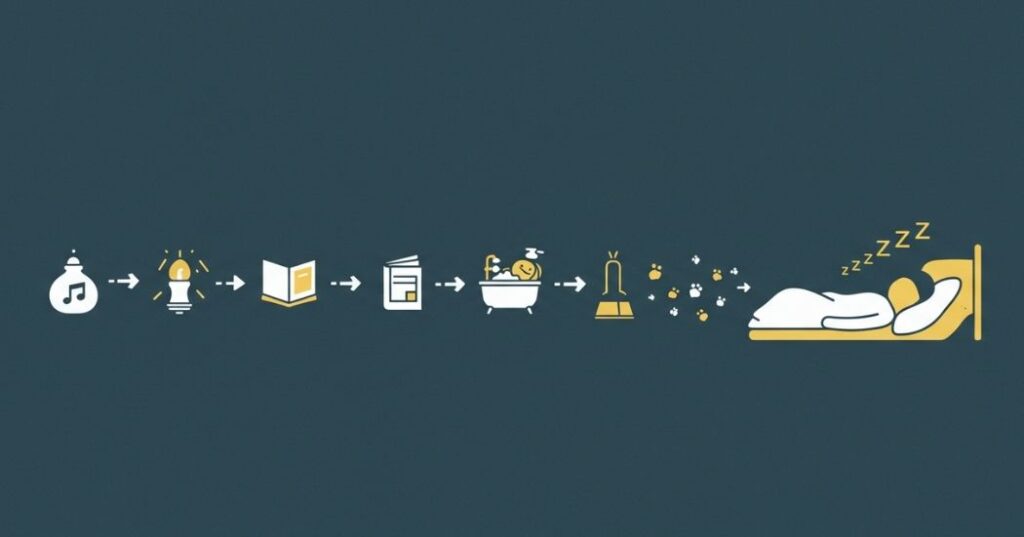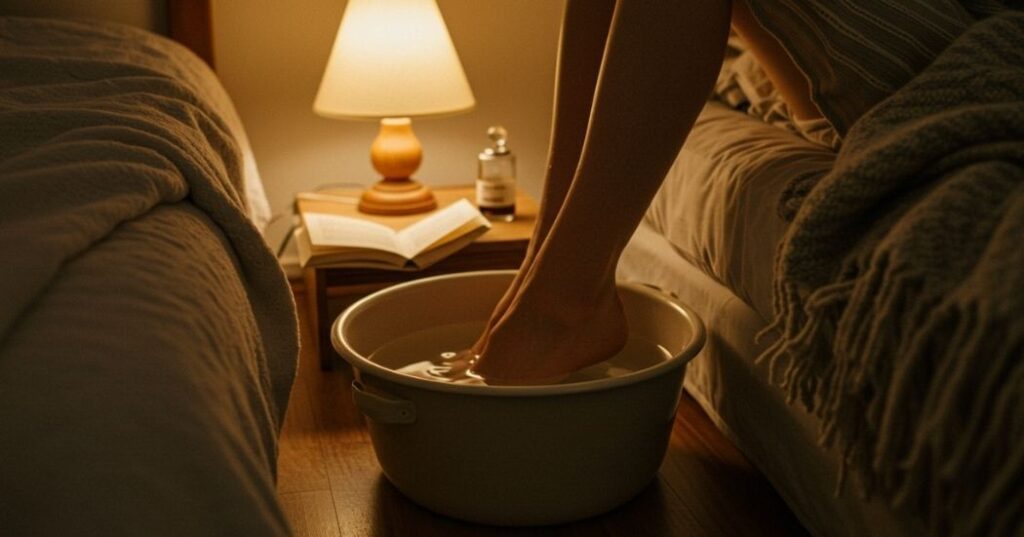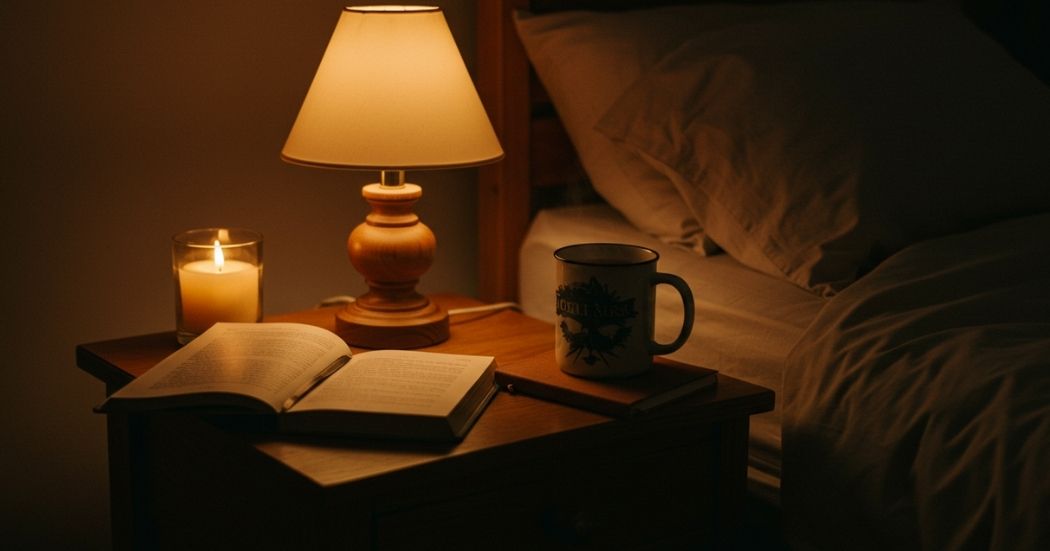The Perfect Wind-Down: Creating a Bedtime Routine for Optimal Sleep Recovery
Struggling to fall asleep—or finding yourself waking up still exhausted, feeling utterly unrestored? The solution to your persistent sleep woes might not be found solely in a new mattress, a specific sleep supplement, or a fleeting habit, but rather in the crucial hour before you even climb into bed.
A consistent, thoughtfully crafted wind-down routine serves as a powerful, deliberate signal to your brain and body: “It’s time to transition from the demands of the day to deep rest and profound recovery.” By intentionally creating this bridge between wakefulness and sleep, you can significantly enhance your sleep quality, effectively reduce accumulated daily stress, and facilitate deeper, more robust physiological and mental restoration. Let’s embark on building your perfect, personalized bedtime routine—step-by-step—to unlock your best sleep yet.
Why a Dedicated Wind-Down Routine Is Your Sleep’s Best Friend

Our modern lives often keep our autonomic nervous system perpetually in “go mode,” dominated by the sympathetic nervous system (the “fight or flight” response). This state, while necessary for daily challenges, actively counteracts the conditions required for sleep. To truly achieve restorative rest, your body needs a deliberate shift to the parasympathetic nervous system (the “rest and digest” mode).
Without this vital transition, you may consistently experience:
- Persistent Racing Thoughts (Pre-Sleep Rumination): Your mind remains relentlessly active, replaying the day’s events, catastrophizing about tomorrow, or simply churning through worries, making relaxation an uphill battle.
- Prolonged Trouble Falling Asleep (High Sleep Latency): It takes an excessive and frustrating amount of time to drift off, often leading to a cascade of anxiety about not sleeping.
- Shallow or Fragmented Sleep: Even if you eventually fall asleep, your rest might be restless, punctuated by frequent, sometimes unnoticed, awakenings. This prevents you from reaching the crucial deep sleep (slow-wave sleep) and REM sleep stages vital for true rejuvenation.
- Chronic Morning Fatigue and Brain Fog: Despite spending sufficient hours in bed, you wake up feeling utterly tired, mentally sluggish, lacking clarity, and generally unrefreshed, impairing your daytime function.
- Elevated Nighttime Cortisol: The body’s stress hormone, cortisol, naturally declines at night. Without a proper wind-down, cortisol levels can remain elevated, actively fighting against the sleep process.
A robust 2019 study published in Sleep Health, the official journal of the National Sleep Foundation, provided compelling scientific evidence: consistently implementing structured nighttime routines significantly improved both sleep onset latency (how quickly participants fell asleep) and overall sleep satisfaction in adult participants. This rigorously supports the effectiveness of a dedicated wind-down practice.
The 7-Step Bedtime Routine for Optimal Sleep Recovery (SEO Focused)

Building an effective bedtime routine isn’t about making drastic, overwhelming changes. Instead, it’s about embracing consistency and intentionality. Here’s a detailed, step-by-step guide designed to optimize both your sleep and your recovery, making your nightly ritual a powerful tool for well-being:
1. Set a Consistent Wind-Down Time: Your Non-Negotiable Bedtime Alarm
Predictability is paramount for training your body’s internal clock, your circadian rhythm. Your brain thrives on knowing what to expect.
- Allocate Dedicated Time: Mark out a consistent window, ideally 60–90 minutes before your target bedtime, to begin your wind-down sequence. This generous buffer allows ample time for your body and mind to gently decelerate from the day’s demands.
- Utilize a Gentle Reminder: Set a recurring, subtle alarm or reminder on your phone or smart speaker to signal the precise start of your wind-down period each night. This transforms it from a fleeting idea into a fixed, non-negotiable part of your evening schedule.
SEO Keyword Focus:
consistent bedtime routine,sleep schedule consistency,circadian rhythm reset,bedtime preparation.Example: If your ideal sleep start time is 10:30 PM, make a firm commitment to begin your wind-down activities by 9:00 PM every single night.
2. Dim the Lights and Power Down Screens: Signaling Melatonin Production to Your Brain
Light, particularly the blue spectrum emitted by electronic devices, is the most potent inhibitor of melatonin, your body’s natural sleep hormone. Strategically reducing your light exposure is a critical, direct signal for your brain to initiate its sleep preparation sequence.
- Reduce Overhead Lighting: Switch off bright overhead lights. Instead, opt for warm-toned, low-wattage lamps or even use carefully placed candles to create a soft, inviting, and calming ambiance.
- Eliminate Bright Screens: Make a firm rule to power down laptops, tablets, and smartphones at the start of your wind-down. If complete avoidance is genuinely impossible, ensure you’re wearing high-quality blue-light blocking glasses (with amber or orange lenses) or activating your device’s “Night Shift” or “red light” mode (which shifts screen colors to warmer tones).
- Consider a Sunset Lamp: These innovative devices gradually dim over a set period, perfectly mimicking a natural sunset. This gentle, diminishing light exposure provides a powerful, subtle cue to your body, guiding it towards sleep.
SEO Keyword Focus:
blue light blocking,melatonin production,screen time before bed,sleep light therapy,digital detox for sleep.
3. Warm Shower or Foot Soak: Triggering Your Body’s Natural Cooling Mechanism
A brief warming of the body before bedtime triggers a crucial, natural physiological response: a subsequent cooling of your core body temperature. This slight dip is a well-established, potent signal for sleep onset and maintenance.
- Short Warm Shower or Bath: Take a relaxing 10-15 minute warm shower or bath. The warmth helps to dilate your blood vessels, allowing body heat to radiate away more efficiently once you step out, initiating the necessary cooling.
- Epsom Salt Foot Soak: If a full bath isn’t feasible, a warm foot soak with Epsom salts (magnesium sulfate) can be remarkably soothing. The magnesium is renowned for its muscle-relaxing properties and can be absorbed through the skin.
- Integrate Aromatherapy: Elevate the experience by adding a few drops of calming essential oils, such as lavender, chamomile, or eucalyptus, to your bath water or a dedicated diffuser in your bathroom.
SEO Keyword Focus:
bedtime shower for sleep,Epsom salt bath for sleep,body temperature regulation sleep,natural sleep aid bath.
4. Write It Down: Offloading the Mental Clutter for a Clear Mind
Pre-sleep rumination—the endless mental loop of thoughts, worries, and to-do lists—is one of the most significant barriers to falling asleep. Effectively getting these thoughts out of your head and onto paper can be profoundly liberating.
- Gratitude Journaling: Dedicate a few minutes to jot down 3 things you’re genuinely grateful for from your day. This simple practice can powerfully shift your mindset to a more positive, calm, and conducive emotional state for sleep.
- Brain Dump/Worry Journal: Pour out any anxieties, unresolved problems, or lingering thoughts from the day onto paper. Don’t edit or censor; just let it flow. This act externalizes the thoughts, preventing them from swirling in your mind.
- Tomorrow’s To-Do List: Systematically transfer any tasks, plans, or reminders for the next day from your active memory to a physical list. This signals to your brain that these items are “stored” and you no longer need to hold onto them or worry about forgetting them overnight.
SEO Keyword Focus:
journaling for sleep,reduce racing thoughts before bed,bedtime anxiety relief,brain dump for sleep,mindfulness for sleep.
5. Gentle Movement or Breathwork: Actively Calming Your Nervous System
Engaging in light physical activity or focused breathing techniques can provide immediate and tangible benefits by actively shifting your nervous system from a state of sympathetic arousal to parasympathetic calm.
- Gentle Stretching or Restorative Yoga: Dedicate 5–10 minutes to very light, non-strenuous stretching or gentle restorative yoga poses. The aim is to release physical tension and improve flexibility without stimulating your body. Absolutely avoid intense cardio, heavy lifting, or vigorous exercise this close to bedtime.
- Mindful Breathwork: Practices like the 4-7-8 breathing technique (inhale for 4 counts, hold for 7, exhale for 8) or box breathing (inhale for 4, hold for 4, exhale for 4, hold for 4) can rapidly activate the parasympathetic nervous system, effectively slowing your heart rate and calming a busy mind.
- Guided NSDR (Non-Sleep Deep Rest) Audio: These structured, guided meditations (like Yoga Nidra) are specifically designed to induce a profound state of conscious relaxation, without necessarily falling asleep. They are exceptionally powerful for unwinding before sleep and reducing mental chatter. Many high-quality, free resources are readily available online.
SEO Keyword Focus:
breathing exercises for sleep,NSDR for relaxation,gentle yoga before bed,nervous system calm for sleep,mindfulness meditation for sleep.
6. Sleep-Supportive Snack or Herbal Tea (Optional & Strategic)
If you genuinely experience mild hunger pangs before bed, a small, thoughtfully chosen snack can prevent these from disrupting your sleep. Moreover, specific foods and beverages can contribute to nutrient availability for recovery and direct sleep promotion.
- Smart Snack Combinations:
- Low-fat cottage cheese + a small banana: This pairing offers slow-digesting casein protein for sustained muscle repair, tryptophan (an amino acid precursor to serotonin and melatonin), and essential minerals like magnesium and potassium.
- A small handful of almonds or walnuts: These provide healthy fats, a good dose of magnesium, and some natural melatonin (especially walnuts).
- Calming Herbal Teas: Sip on non-caffeinated herbal teas such as chamomile, lemon balm, valerian root, or passionflower. These herbs are renowned for their natural calming properties and can gently prepare your body for rest.
- Crucial Avoidances in the Evening:
- High-Sugar Snacks and Refined Carbohydrates: These lead to rapid blood sugar spikes followed by abrupt crashes, which can severely disrupt sleep continuity, trigger cortisol release, and hinder the body’s natural fat-burning processes during sleep.
- Alcohol: While it might initially induce drowsiness, alcohol profoundly fragments sleep architecture. It significantly reduces time spent in crucial REM and deep sleep stages, leading to poor recovery and subsequent rebound awakenings as your body metabolizes it.
- Heavy, Fatty, or Fried Meals: These demand significant digestive effort, keeping your body’s systems actively engaged when they should be winding down for rest, often leading to indigestion, heartburn, and physical discomfort that directly impedes sleep.
SEO Keyword Focus:
bedtime snacks for sleep,herbal tea for sleep,foods to avoid before sleep,muscle recovery foods at night,blood sugar and sleep.
7. Get Into Bed (and Stay There Only for Sleep): Reinforcing Association for Insomnia Recovery
This final step is paramount and directly applies the principles of Stimulus Control Therapy from CBT-I (Cognitive Behavioral Therapy for Insomnia). Your bed should exclusively be a cue for sleep and intimacy, nothing else.
- Enter When Genuinely Sleepy: Make it a rule: only get into bed when you genuinely feel drowsy and ready to sleep. Avoid lying there waiting for sleep to arrive.
- No Screens in Bed: Absolutely commit to avoiding reading on your phone, tablet, watching TV, or working in bed. These activities associate your bed with wakefulness and mental stimulation.
- Optimize Sensory Input: Ensure your sleep environment is pitch black. Use a comfortable, light-blocking eye mask. If noise is an issue, utilize a white noise machine or high-quality earplugs to mask disruptive sounds.
- If Awake for >20 Mins, Get Up: If you find yourself unable to fall asleep after approximately 15-20 minutes of trying, or if you wake up during the night and can’t get back to sleep within that timeframe, get out of bed. Go to another room and engage in a low-stimulus, non-exciting activity (e.g., quiet reading under dim light, gentle stretching, mindful breathing) until you feel genuinely sleepy again. Only then, return to bed. This prevents your brain from associating the bed with wakefulness, frustration, or a struggle.
SEO Keyword Focus:
stimulus control therapy for insomnia,insomnia CBT-I techniques,bed for sleep only,waking up at night solutions,sleep re-training.
Smart Tools to Further Enhance Your Personalized Wind-Down Routine
Beyond the core steps, certain technologies and comfort items can further optimize your sleep environment and nervous system state, serving as excellent complements to your routine:
- Sunset Lamp or Red Light Therapy Devices: These innovative lamps gradually dim their light and emit red or amber wavelengths, which are non-disruptive to melatonin production. They effectively mimic the natural sunset, providing a powerful, subtle cue to prepare your body for rest.
- Weighted Blanket: The gentle, evenly distributed pressure of a weighted blanket can create a profound sense of calm and security. This deep pressure stimulation is believed to activate the parasympathetic nervous system and stimulate the release of oxytocin and serotonin, promoting deep relaxation and reducing anxiety.
- High-Quality Eye Mask & Earplugs: These are indispensable for creating a truly dark, quiet sleep environment, especially if you live in a noisy urban area, have light-emitting electronics, or are a shift worker needing to sleep during daylight hours.
- Sleep Tracking App (Use with Caution): While some individuals find sleep tracking helpful for understanding patterns and identifying areas for improvement, it’s crucial to use these tools only if they reduce—not increase—anxiety about your sleep. For true recovery, focus on how you feel upon waking rather than obsessing over data metrics.
Ready to take profound control of your nights and truly prioritize your recovery? Download our complimentary Wind-Down Routine Checklist today. This actionable guide will empower you to easily build and consistently implement your personalized night ritual for deeper, more restorative sleep starting tonight.
🌙 Final Thoughts: Embrace Consistency Over Perfection for Lasting Sleep

Remember, you don’t need a flawless, rigid bedtime routine from day one; what you truly need is consistency. A calming, well-structured bedtime routine isn’t merely a luxury; it is an essential, powerful sleep recovery tool and a profound investment in your overall physical health, mental well-being, and daily performance.
Begin by implementing just one or two of these steps tonight. Gradually build from there, incrementally adding more elements as they feel comfortable, sustainable, and beneficial for your unique needs. Allow your intentional routine to transform from a set of tasks into a cherished, deeply ingrained ritual that consistently supports your rest, fuels your recovery, and enhances your overall vitality. Embrace the transformative power of the wind-down; your body, mind, and future self will undoubtedly thank you.
Ready to experience significantly better sleep tonight and dramatically enhance your recovery from daily demands? Download our comprehensive 7-Step Wind-Down Routine checklist now. It’s your blueprint to building your best night’s sleep yet and unlocking true, restorative rest. What single step will you commit to tonight to begin your journey to optimal sleep?
✨ What single step will you commit to tonight to begin your journey to optimal sleep?
🔗 Explore More Sleep-Boosting Routines
Building your perfect bedtime wind-down is only the beginning.
Here are more ways to enhance your consistency and nightly recovery:
- → Daily Self-Care Routine Checklist: Your Expert-Backed Sleep Support
- → Simple Morning Wellness Routine: A Calm Start for Better Sleep at Night
- → Wellness Routine for Working Women: 5 Daily Habits for Better Balance
These routines complement your night prep—and support sleep before your head even hits the pillow.
📚 References
- American Sleep Association. (2022). Sleep Hygiene Tips.
https://www.sleepassociation.org/about-sleep/sleep-hygiene-tips/

